An Analysis of NHS Leadership, Training, and Talent Management Report
VerifiedAdded on 2020/12/09
|10
|2678
|330
Report
AI Summary
This report provides an overview of the National Health Service (NHS), focusing on key areas such as leadership and management, training and development, and talent management. It explores the different models and factors influencing these areas, including the clinical leadership competency model, the ADDIE model for training, and the individual organization talent strategy model. The report examines internal and external factors affecting the NHS, such as government support, technological advancements, and staff shortages. Furthermore, the report delves into the importance of human resources, training programs, and talent management strategies in enhancing the quality of healthcare services. Recommendations are provided to improve leadership, training, and development within the NHS to optimize patient care and organizational effectiveness. The report also includes an examination of the various factors that influence the NHS including internal and external, and their impact on the organization's ability to provide effective care.
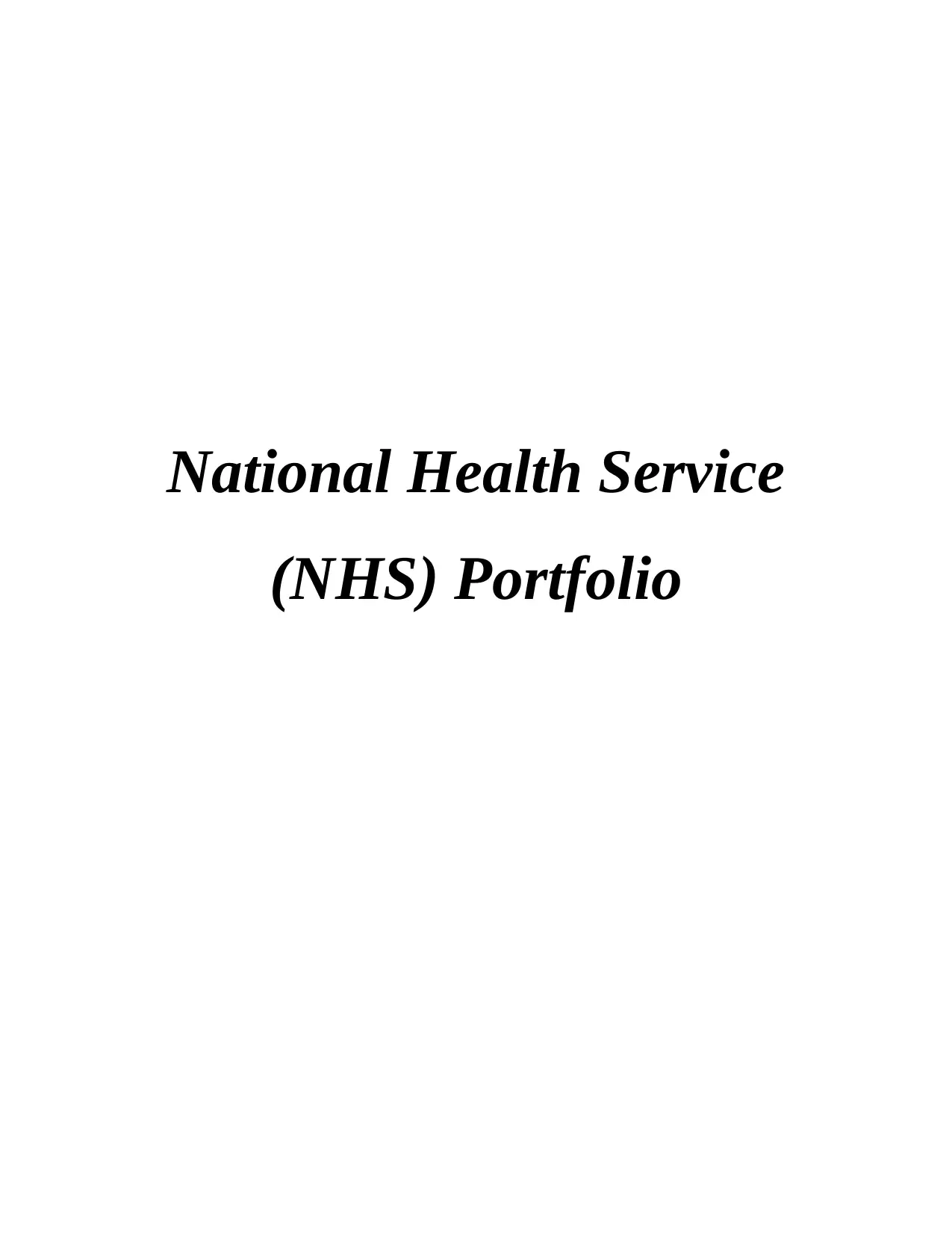
National Health Service
(NHS) Portfolio
(NHS) Portfolio
Paraphrase This Document
Need a fresh take? Get an instant paraphrase of this document with our AI Paraphraser
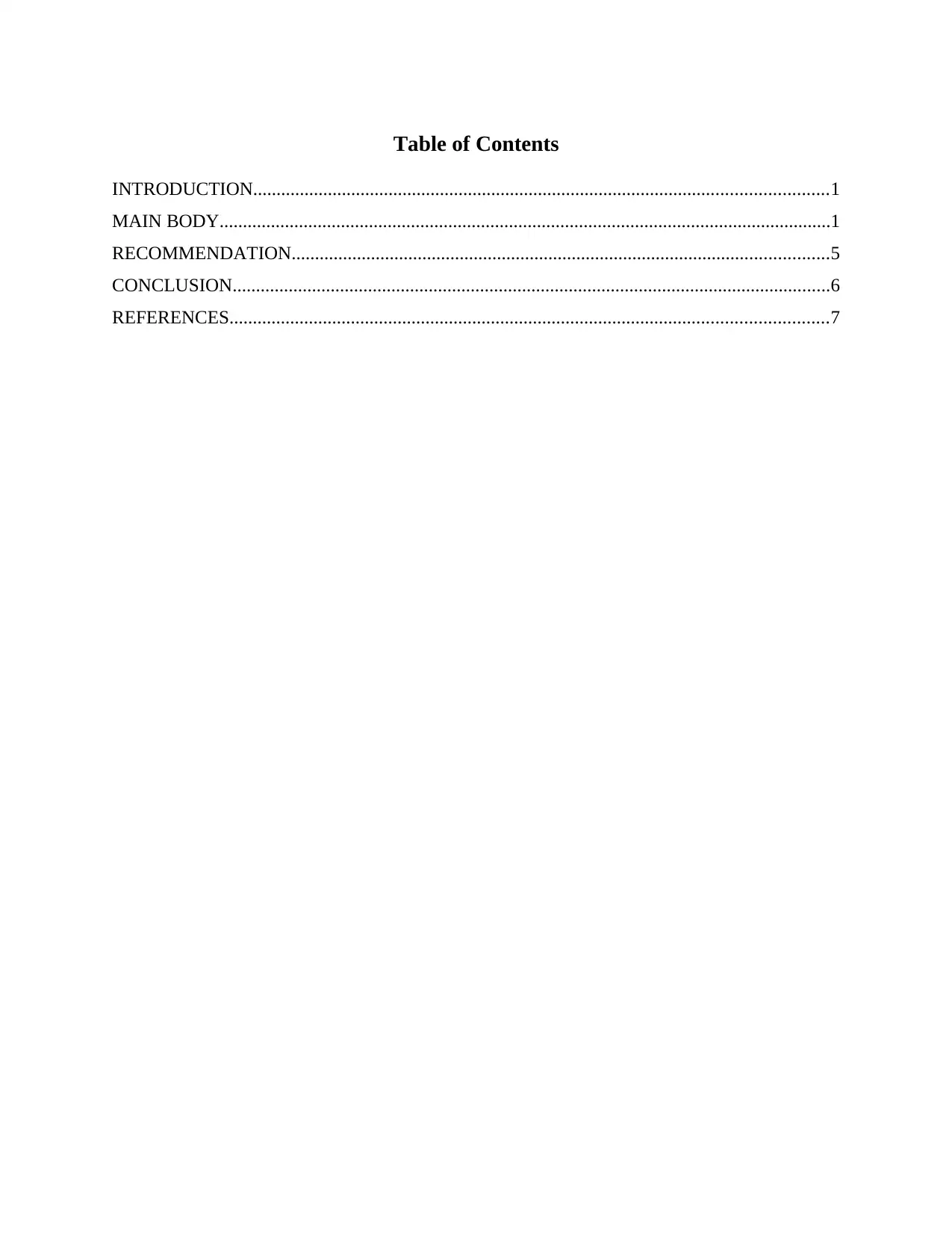
Table of Contents
INTRODUCTION...........................................................................................................................1
MAIN BODY...................................................................................................................................1
RECOMMENDATION...................................................................................................................5
CONCLUSION................................................................................................................................6
REFERENCES................................................................................................................................7
INTRODUCTION...........................................................................................................................1
MAIN BODY...................................................................................................................................1
RECOMMENDATION...................................................................................................................5
CONCLUSION................................................................................................................................6
REFERENCES................................................................................................................................7

INTRODUCTION
National health service is national healthcare system which publicly funded for England.
This health service is largest and single payer healthcare system, primarily funded by
government funding. NHS will be overseen by department of health and social care. It also
provides all legal services and residents for people who are with health care needs. NHS gives
free medical care to every individual who is living in England (Mitchell and Gill, 2014). This
system plays major role to provide care and treatment to large number of people. This
assignment will focus on three different areas of NHS and different theoretical models. Various
roles of NHS management and function of HR in the supporting management. And also internal
and external factors which influence the given three areas.
MAIN BODY
National health services include in-patient care, dentistry, ophthalmology, long term
healthcare and primary care. Services given are administrated in separate group such as general
practitioner & dental services, local health authority services and hospital & specialist services.
General practitioners provide primary medical care to group of individuals who register with
these physicians. These dentists and doctors operates their practices and paid by government
based on individuals registered with them. Their services organized locally by executive council.
Specialist and hospital services are given by professionals on the government payment working
in other facilities and government owned hospitals which are under direction of the regional
authorities which are known as hospital boards (Krachler and Greer, 2015). NHS also include
local health authority services which provide child welfare and maternity, home nursing,
ambulance services, immunization, posthospital, different education and preventive services.
They can also regulate day nurses for the children as well as family planning clinics.
National health service is to provide social and health services to people on free of cost
but the major problem which is faced by this organization is increasing waiting time to get
treatment and care. In NHS there is shortage of of staff due to maternity leave and short-terms
illness. This problem is major as some people do not get treatment due to waiting period. This
issue effects to patient and organization in negative way.
Leadership and management: Concept of the clinical leadership and management in
NHS arose preponderating from describing role of healthcare workers taking up the managerial
1
National health service is national healthcare system which publicly funded for England.
This health service is largest and single payer healthcare system, primarily funded by
government funding. NHS will be overseen by department of health and social care. It also
provides all legal services and residents for people who are with health care needs. NHS gives
free medical care to every individual who is living in England (Mitchell and Gill, 2014). This
system plays major role to provide care and treatment to large number of people. This
assignment will focus on three different areas of NHS and different theoretical models. Various
roles of NHS management and function of HR in the supporting management. And also internal
and external factors which influence the given three areas.
MAIN BODY
National health services include in-patient care, dentistry, ophthalmology, long term
healthcare and primary care. Services given are administrated in separate group such as general
practitioner & dental services, local health authority services and hospital & specialist services.
General practitioners provide primary medical care to group of individuals who register with
these physicians. These dentists and doctors operates their practices and paid by government
based on individuals registered with them. Their services organized locally by executive council.
Specialist and hospital services are given by professionals on the government payment working
in other facilities and government owned hospitals which are under direction of the regional
authorities which are known as hospital boards (Krachler and Greer, 2015). NHS also include
local health authority services which provide child welfare and maternity, home nursing,
ambulance services, immunization, posthospital, different education and preventive services.
They can also regulate day nurses for the children as well as family planning clinics.
National health service is to provide social and health services to people on free of cost
but the major problem which is faced by this organization is increasing waiting time to get
treatment and care. In NHS there is shortage of of staff due to maternity leave and short-terms
illness. This problem is major as some people do not get treatment due to waiting period. This
issue effects to patient and organization in negative way.
Leadership and management: Concept of the clinical leadership and management in
NHS arose preponderating from describing role of healthcare workers taking up the managerial
1
⊘ This is a preview!⊘
Do you want full access?
Subscribe today to unlock all pages.

Trusted by 1+ million students worldwide
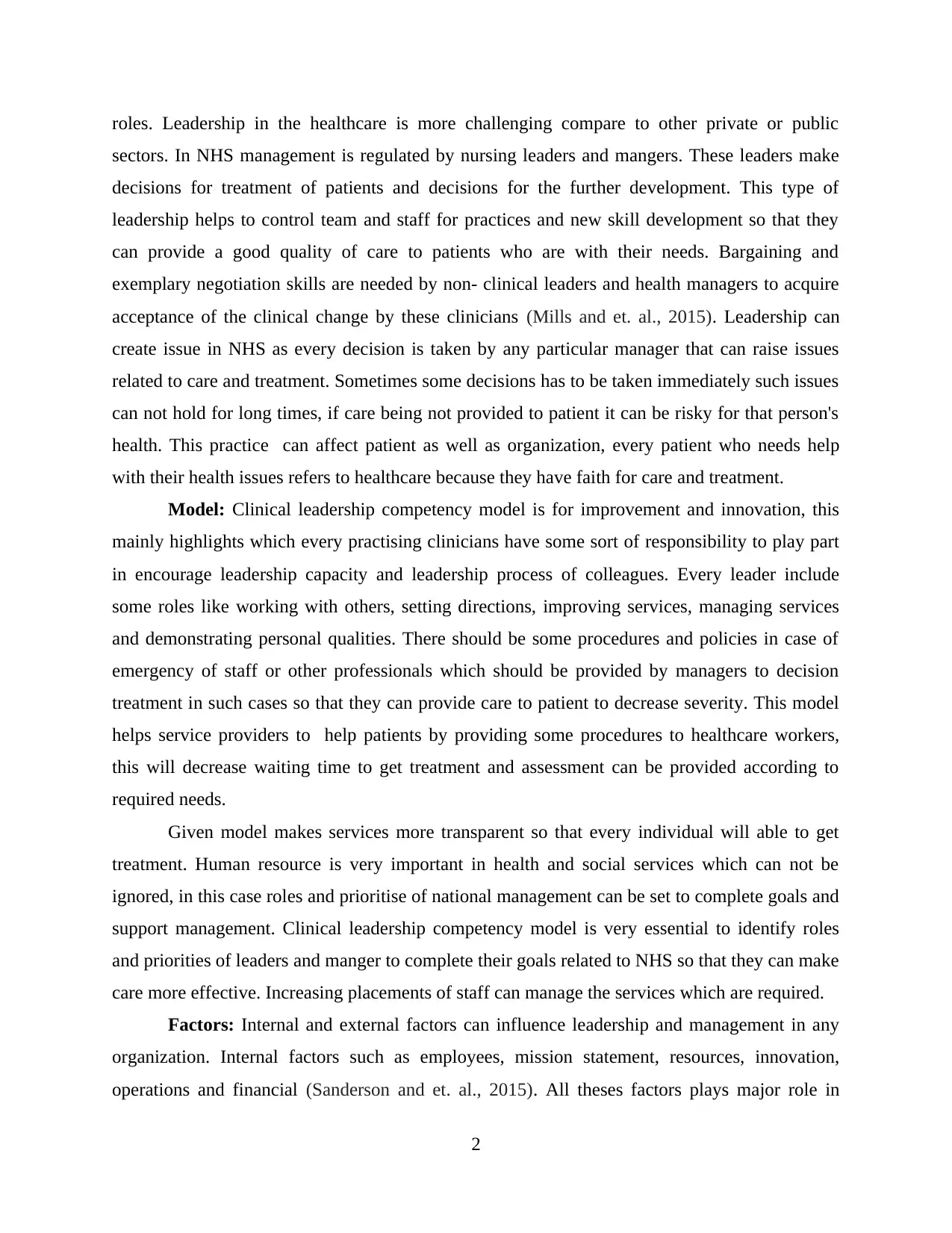
roles. Leadership in the healthcare is more challenging compare to other private or public
sectors. In NHS management is regulated by nursing leaders and mangers. These leaders make
decisions for treatment of patients and decisions for the further development. This type of
leadership helps to control team and staff for practices and new skill development so that they
can provide a good quality of care to patients who are with their needs. Bargaining and
exemplary negotiation skills are needed by non- clinical leaders and health managers to acquire
acceptance of the clinical change by these clinicians (Mills and et. al., 2015). Leadership can
create issue in NHS as every decision is taken by any particular manager that can raise issues
related to care and treatment. Sometimes some decisions has to be taken immediately such issues
can not hold for long times, if care being not provided to patient it can be risky for that person's
health. This practice can affect patient as well as organization, every patient who needs help
with their health issues refers to healthcare because they have faith for care and treatment.
Model: Clinical leadership competency model is for improvement and innovation, this
mainly highlights which every practising clinicians have some sort of responsibility to play part
in encourage leadership capacity and leadership process of colleagues. Every leader include
some roles like working with others, setting directions, improving services, managing services
and demonstrating personal qualities. There should be some procedures and policies in case of
emergency of staff or other professionals which should be provided by managers to decision
treatment in such cases so that they can provide care to patient to decrease severity. This model
helps service providers to help patients by providing some procedures to healthcare workers,
this will decrease waiting time to get treatment and assessment can be provided according to
required needs.
Given model makes services more transparent so that every individual will able to get
treatment. Human resource is very important in health and social services which can not be
ignored, in this case roles and prioritise of national management can be set to complete goals and
support management. Clinical leadership competency model is very essential to identify roles
and priorities of leaders and manger to complete their goals related to NHS so that they can make
care more effective. Increasing placements of staff can manage the services which are required.
Factors: Internal and external factors can influence leadership and management in any
organization. Internal factors such as employees, mission statement, resources, innovation,
operations and financial (Sanderson and et. al., 2015). All theses factors plays major role in
2
sectors. In NHS management is regulated by nursing leaders and mangers. These leaders make
decisions for treatment of patients and decisions for the further development. This type of
leadership helps to control team and staff for practices and new skill development so that they
can provide a good quality of care to patients who are with their needs. Bargaining and
exemplary negotiation skills are needed by non- clinical leaders and health managers to acquire
acceptance of the clinical change by these clinicians (Mills and et. al., 2015). Leadership can
create issue in NHS as every decision is taken by any particular manager that can raise issues
related to care and treatment. Sometimes some decisions has to be taken immediately such issues
can not hold for long times, if care being not provided to patient it can be risky for that person's
health. This practice can affect patient as well as organization, every patient who needs help
with their health issues refers to healthcare because they have faith for care and treatment.
Model: Clinical leadership competency model is for improvement and innovation, this
mainly highlights which every practising clinicians have some sort of responsibility to play part
in encourage leadership capacity and leadership process of colleagues. Every leader include
some roles like working with others, setting directions, improving services, managing services
and demonstrating personal qualities. There should be some procedures and policies in case of
emergency of staff or other professionals which should be provided by managers to decision
treatment in such cases so that they can provide care to patient to decrease severity. This model
helps service providers to help patients by providing some procedures to healthcare workers,
this will decrease waiting time to get treatment and assessment can be provided according to
required needs.
Given model makes services more transparent so that every individual will able to get
treatment. Human resource is very important in health and social services which can not be
ignored, in this case roles and prioritise of national management can be set to complete goals and
support management. Clinical leadership competency model is very essential to identify roles
and priorities of leaders and manger to complete their goals related to NHS so that they can make
care more effective. Increasing placements of staff can manage the services which are required.
Factors: Internal and external factors can influence leadership and management in any
organization. Internal factors such as employees, mission statement, resources, innovation,
operations and financial (Sanderson and et. al., 2015). All theses factors plays major role in
2
Paraphrase This Document
Need a fresh take? Get an instant paraphrase of this document with our AI Paraphraser
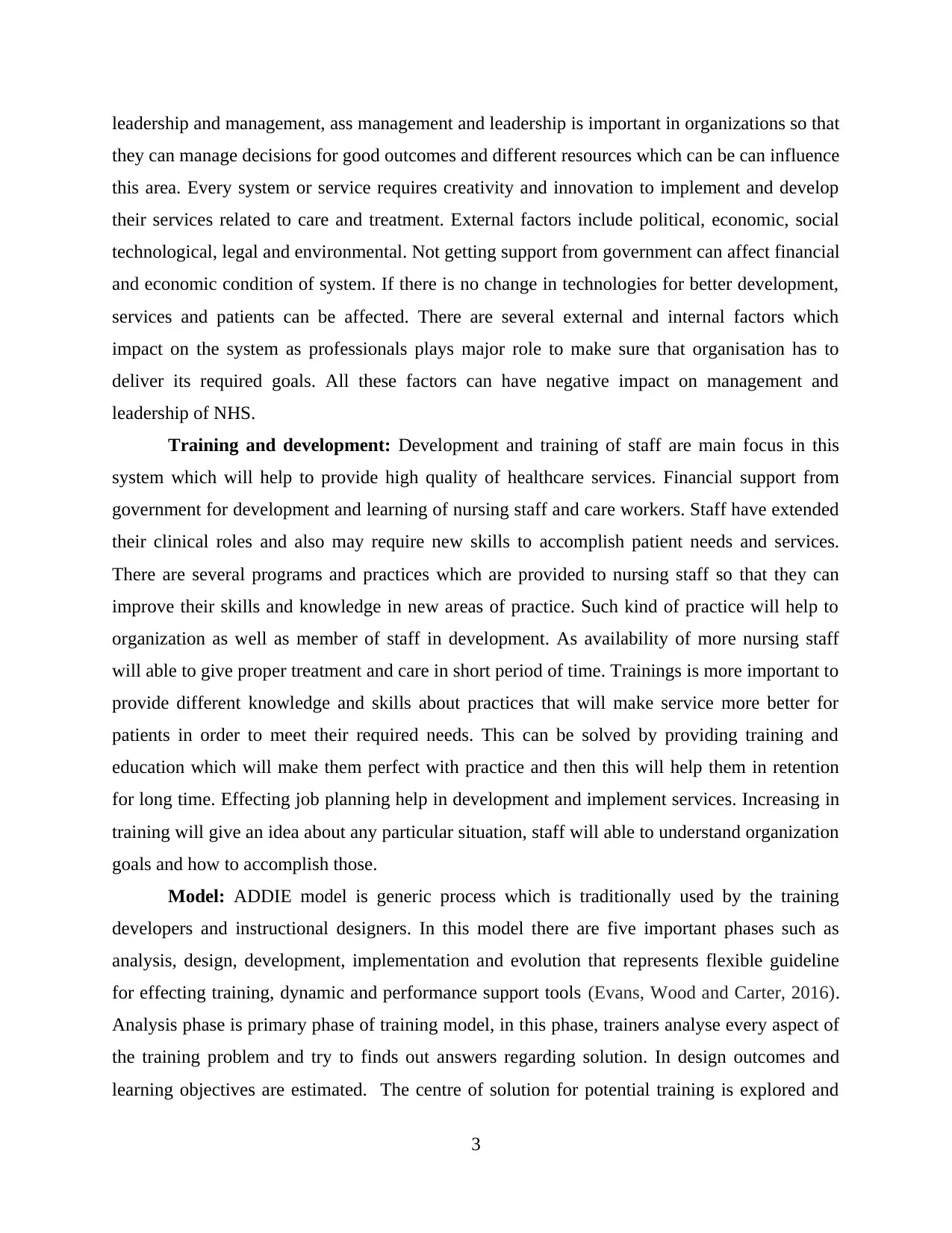
leadership and management, ass management and leadership is important in organizations so that
they can manage decisions for good outcomes and different resources which can be can influence
this area. Every system or service requires creativity and innovation to implement and develop
their services related to care and treatment. External factors include political, economic, social
technological, legal and environmental. Not getting support from government can affect financial
and economic condition of system. If there is no change in technologies for better development,
services and patients can be affected. There are several external and internal factors which
impact on the system as professionals plays major role to make sure that organisation has to
deliver its required goals. All these factors can have negative impact on management and
leadership of NHS.
Training and development: Development and training of staff are main focus in this
system which will help to provide high quality of healthcare services. Financial support from
government for development and learning of nursing staff and care workers. Staff have extended
their clinical roles and also may require new skills to accomplish patient needs and services.
There are several programs and practices which are provided to nursing staff so that they can
improve their skills and knowledge in new areas of practice. Such kind of practice will help to
organization as well as member of staff in development. As availability of more nursing staff
will able to give proper treatment and care in short period of time. Trainings is more important to
provide different knowledge and skills about practices that will make service more better for
patients in order to meet their required needs. This can be solved by providing training and
education which will make them perfect with practice and then this will help them in retention
for long time. Effecting job planning help in development and implement services. Increasing in
training will give an idea about any particular situation, staff will able to understand organization
goals and how to accomplish those.
Model: ADDIE model is generic process which is traditionally used by the training
developers and instructional designers. In this model there are five important phases such as
analysis, design, development, implementation and evolution that represents flexible guideline
for effecting training, dynamic and performance support tools (Evans, Wood and Carter, 2016).
Analysis phase is primary phase of training model, in this phase, trainers analyse every aspect of
the training problem and try to finds out answers regarding solution. In design outcomes and
learning objectives are estimated. The centre of solution for potential training is explored and
3
they can manage decisions for good outcomes and different resources which can be can influence
this area. Every system or service requires creativity and innovation to implement and develop
their services related to care and treatment. External factors include political, economic, social
technological, legal and environmental. Not getting support from government can affect financial
and economic condition of system. If there is no change in technologies for better development,
services and patients can be affected. There are several external and internal factors which
impact on the system as professionals plays major role to make sure that organisation has to
deliver its required goals. All these factors can have negative impact on management and
leadership of NHS.
Training and development: Development and training of staff are main focus in this
system which will help to provide high quality of healthcare services. Financial support from
government for development and learning of nursing staff and care workers. Staff have extended
their clinical roles and also may require new skills to accomplish patient needs and services.
There are several programs and practices which are provided to nursing staff so that they can
improve their skills and knowledge in new areas of practice. Such kind of practice will help to
organization as well as member of staff in development. As availability of more nursing staff
will able to give proper treatment and care in short period of time. Trainings is more important to
provide different knowledge and skills about practices that will make service more better for
patients in order to meet their required needs. This can be solved by providing training and
education which will make them perfect with practice and then this will help them in retention
for long time. Effecting job planning help in development and implement services. Increasing in
training will give an idea about any particular situation, staff will able to understand organization
goals and how to accomplish those.
Model: ADDIE model is generic process which is traditionally used by the training
developers and instructional designers. In this model there are five important phases such as
analysis, design, development, implementation and evolution that represents flexible guideline
for effecting training, dynamic and performance support tools (Evans, Wood and Carter, 2016).
Analysis phase is primary phase of training model, in this phase, trainers analyse every aspect of
the training problem and try to finds out answers regarding solution. In design outcomes and
learning objectives are estimated. The centre of solution for potential training is explored and
3
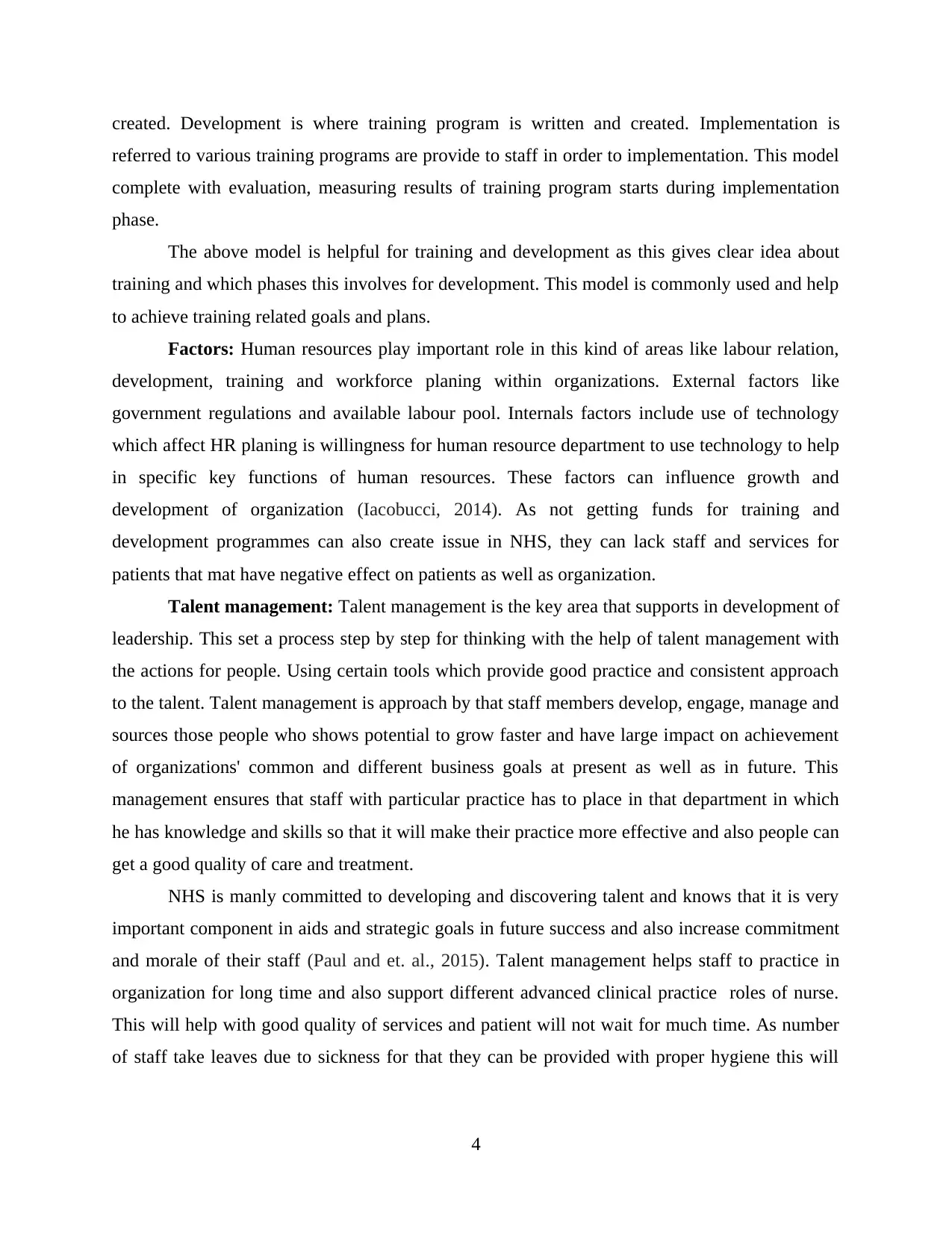
created. Development is where training program is written and created. Implementation is
referred to various training programs are provide to staff in order to implementation. This model
complete with evaluation, measuring results of training program starts during implementation
phase.
The above model is helpful for training and development as this gives clear idea about
training and which phases this involves for development. This model is commonly used and help
to achieve training related goals and plans.
Factors: Human resources play important role in this kind of areas like labour relation,
development, training and workforce planing within organizations. External factors like
government regulations and available labour pool. Internals factors include use of technology
which affect HR planing is willingness for human resource department to use technology to help
in specific key functions of human resources. These factors can influence growth and
development of organization (Iacobucci, 2014). As not getting funds for training and
development programmes can also create issue in NHS, they can lack staff and services for
patients that mat have negative effect on patients as well as organization.
Talent management: Talent management is the key area that supports in development of
leadership. This set a process step by step for thinking with the help of talent management with
the actions for people. Using certain tools which provide good practice and consistent approach
to the talent. Talent management is approach by that staff members develop, engage, manage and
sources those people who shows potential to grow faster and have large impact on achievement
of organizations' common and different business goals at present as well as in future. This
management ensures that staff with particular practice has to place in that department in which
he has knowledge and skills so that it will make their practice more effective and also people can
get a good quality of care and treatment.
NHS is manly committed to developing and discovering talent and knows that it is very
important component in aids and strategic goals in future success and also increase commitment
and morale of their staff (Paul and et. al., 2015). Talent management helps staff to practice in
organization for long time and also support different advanced clinical practice roles of nurse.
This will help with good quality of services and patient will not wait for much time. As number
of staff take leaves due to sickness for that they can be provided with proper hygiene this will
4
referred to various training programs are provide to staff in order to implementation. This model
complete with evaluation, measuring results of training program starts during implementation
phase.
The above model is helpful for training and development as this gives clear idea about
training and which phases this involves for development. This model is commonly used and help
to achieve training related goals and plans.
Factors: Human resources play important role in this kind of areas like labour relation,
development, training and workforce planing within organizations. External factors like
government regulations and available labour pool. Internals factors include use of technology
which affect HR planing is willingness for human resource department to use technology to help
in specific key functions of human resources. These factors can influence growth and
development of organization (Iacobucci, 2014). As not getting funds for training and
development programmes can also create issue in NHS, they can lack staff and services for
patients that mat have negative effect on patients as well as organization.
Talent management: Talent management is the key area that supports in development of
leadership. This set a process step by step for thinking with the help of talent management with
the actions for people. Using certain tools which provide good practice and consistent approach
to the talent. Talent management is approach by that staff members develop, engage, manage and
sources those people who shows potential to grow faster and have large impact on achievement
of organizations' common and different business goals at present as well as in future. This
management ensures that staff with particular practice has to place in that department in which
he has knowledge and skills so that it will make their practice more effective and also people can
get a good quality of care and treatment.
NHS is manly committed to developing and discovering talent and knows that it is very
important component in aids and strategic goals in future success and also increase commitment
and morale of their staff (Paul and et. al., 2015). Talent management helps staff to practice in
organization for long time and also support different advanced clinical practice roles of nurse.
This will help with good quality of services and patient will not wait for much time. As number
of staff take leaves due to sickness for that they can be provided with proper hygiene this will
4
⊘ This is a preview!⊘
Do you want full access?
Subscribe today to unlock all pages.

Trusted by 1+ million students worldwide
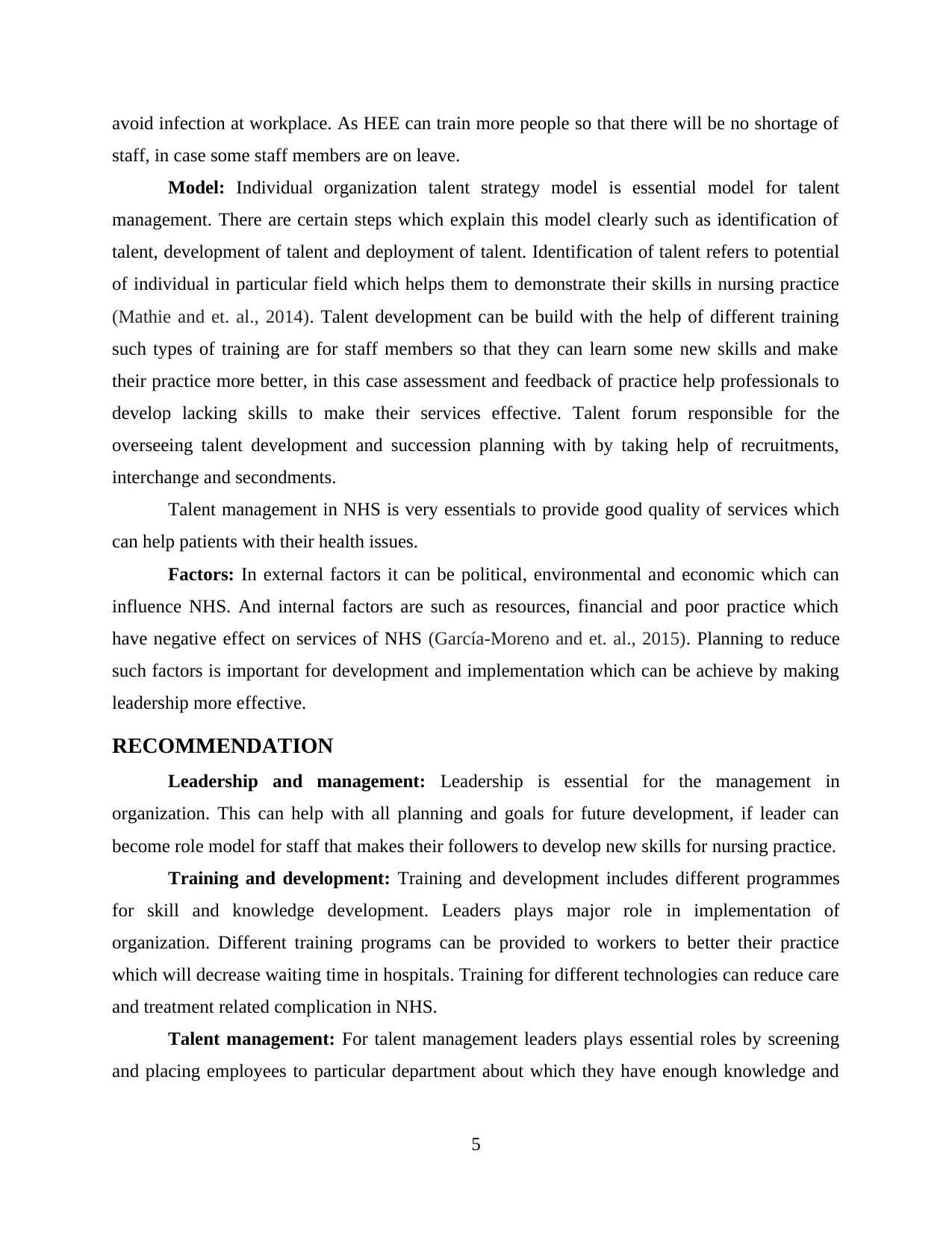
avoid infection at workplace. As HEE can train more people so that there will be no shortage of
staff, in case some staff members are on leave.
Model: Individual organization talent strategy model is essential model for talent
management. There are certain steps which explain this model clearly such as identification of
talent, development of talent and deployment of talent. Identification of talent refers to potential
of individual in particular field which helps them to demonstrate their skills in nursing practice
(Mathie and et. al., 2014). Talent development can be build with the help of different training
such types of training are for staff members so that they can learn some new skills and make
their practice more better, in this case assessment and feedback of practice help professionals to
develop lacking skills to make their services effective. Talent forum responsible for the
overseeing talent development and succession planning with by taking help of recruitments,
interchange and secondments.
Talent management in NHS is very essentials to provide good quality of services which
can help patients with their health issues.
Factors: In external factors it can be political, environmental and economic which can
influence NHS. And internal factors are such as resources, financial and poor practice which
have negative effect on services of NHS (García-Moreno and et. al., 2015). Planning to reduce
such factors is important for development and implementation which can be achieve by making
leadership more effective.
RECOMMENDATION
Leadership and management: Leadership is essential for the management in
organization. This can help with all planning and goals for future development, if leader can
become role model for staff that makes their followers to develop new skills for nursing practice.
Training and development: Training and development includes different programmes
for skill and knowledge development. Leaders plays major role in implementation of
organization. Different training programs can be provided to workers to better their practice
which will decrease waiting time in hospitals. Training for different technologies can reduce care
and treatment related complication in NHS.
Talent management: For talent management leaders plays essential roles by screening
and placing employees to particular department about which they have enough knowledge and
5
staff, in case some staff members are on leave.
Model: Individual organization talent strategy model is essential model for talent
management. There are certain steps which explain this model clearly such as identification of
talent, development of talent and deployment of talent. Identification of talent refers to potential
of individual in particular field which helps them to demonstrate their skills in nursing practice
(Mathie and et. al., 2014). Talent development can be build with the help of different training
such types of training are for staff members so that they can learn some new skills and make
their practice more better, in this case assessment and feedback of practice help professionals to
develop lacking skills to make their services effective. Talent forum responsible for the
overseeing talent development and succession planning with by taking help of recruitments,
interchange and secondments.
Talent management in NHS is very essentials to provide good quality of services which
can help patients with their health issues.
Factors: In external factors it can be political, environmental and economic which can
influence NHS. And internal factors are such as resources, financial and poor practice which
have negative effect on services of NHS (García-Moreno and et. al., 2015). Planning to reduce
such factors is important for development and implementation which can be achieve by making
leadership more effective.
RECOMMENDATION
Leadership and management: Leadership is essential for the management in
organization. This can help with all planning and goals for future development, if leader can
become role model for staff that makes their followers to develop new skills for nursing practice.
Training and development: Training and development includes different programmes
for skill and knowledge development. Leaders plays major role in implementation of
organization. Different training programs can be provided to workers to better their practice
which will decrease waiting time in hospitals. Training for different technologies can reduce care
and treatment related complication in NHS.
Talent management: For talent management leaders plays essential roles by screening
and placing employees to particular department about which they have enough knowledge and
5
Paraphrase This Document
Need a fresh take? Get an instant paraphrase of this document with our AI Paraphraser
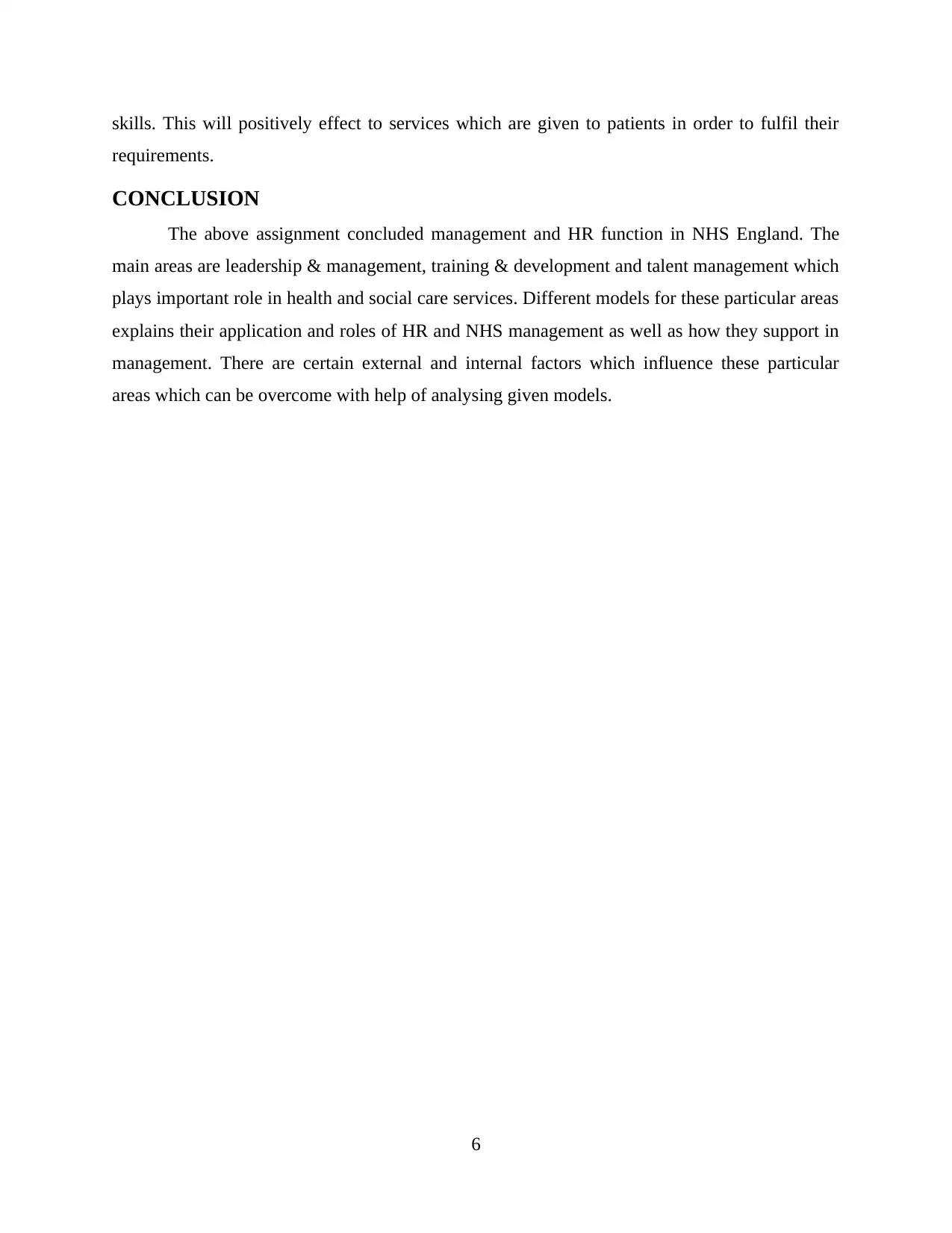
skills. This will positively effect to services which are given to patients in order to fulfil their
requirements.
CONCLUSION
The above assignment concluded management and HR function in NHS England. The
main areas are leadership & management, training & development and talent management which
plays important role in health and social care services. Different models for these particular areas
explains their application and roles of HR and NHS management as well as how they support in
management. There are certain external and internal factors which influence these particular
areas which can be overcome with help of analysing given models.
6
requirements.
CONCLUSION
The above assignment concluded management and HR function in NHS England. The
main areas are leadership & management, training & development and talent management which
plays important role in health and social care services. Different models for these particular areas
explains their application and roles of HR and NHS management as well as how they support in
management. There are certain external and internal factors which influence these particular
areas which can be overcome with help of analysing given models.
6
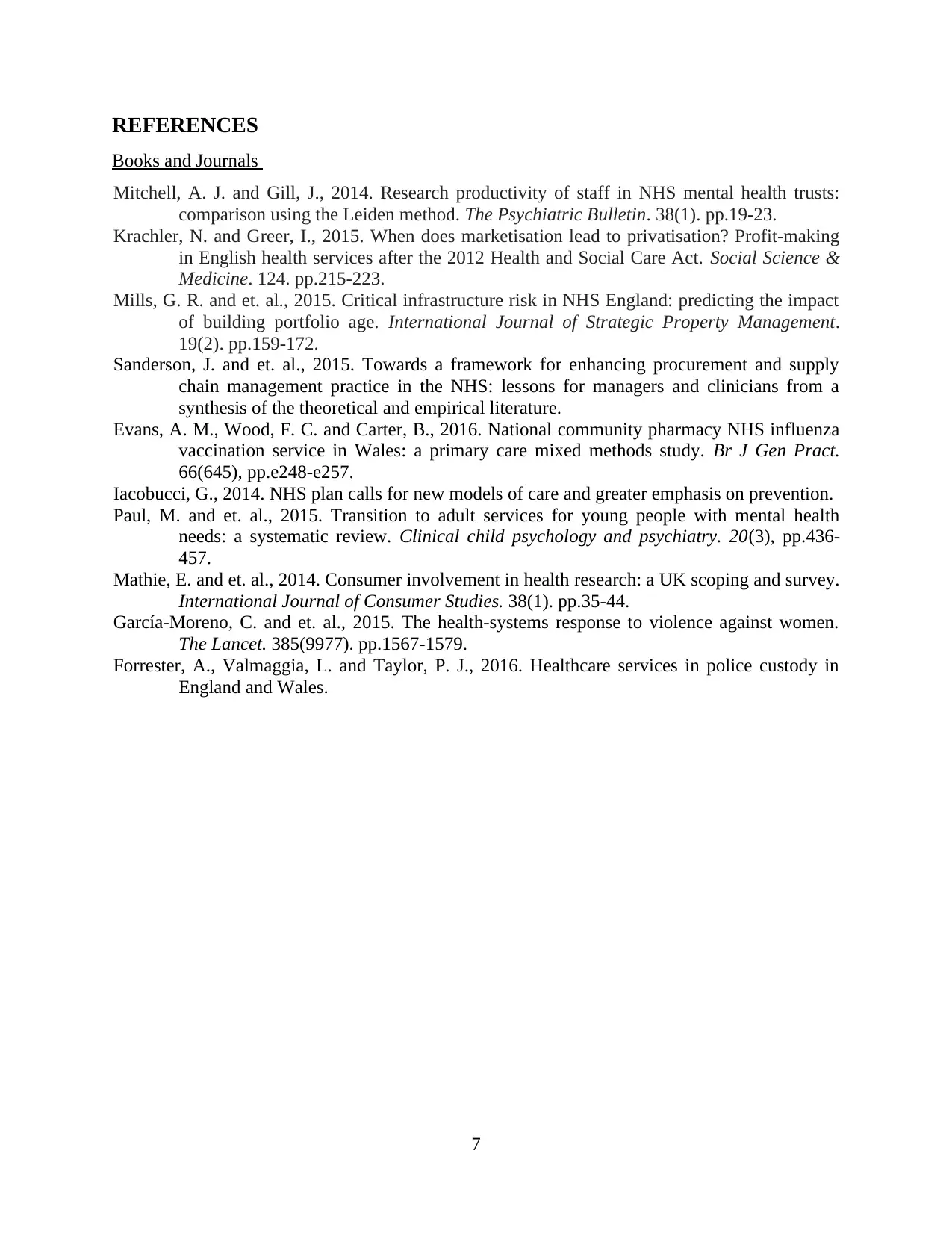
REFERENCES
Books and Journals
Mitchell, A. J. and Gill, J., 2014. Research productivity of staff in NHS mental health trusts:
comparison using the Leiden method. The Psychiatric Bulletin. 38(1). pp.19-23.
Krachler, N. and Greer, I., 2015. When does marketisation lead to privatisation? Profit-making
in English health services after the 2012 Health and Social Care Act. Social Science &
Medicine. 124. pp.215-223.
Mills, G. R. and et. al., 2015. Critical infrastructure risk in NHS England: predicting the impact
of building portfolio age. International Journal of Strategic Property Management.
19(2). pp.159-172.
Sanderson, J. and et. al., 2015. Towards a framework for enhancing procurement and supply
chain management practice in the NHS: lessons for managers and clinicians from a
synthesis of the theoretical and empirical literature.
Evans, A. M., Wood, F. C. and Carter, B., 2016. National community pharmacy NHS influenza
vaccination service in Wales: a primary care mixed methods study. Br J Gen Pract.
66(645), pp.e248-e257.
Iacobucci, G., 2014. NHS plan calls for new models of care and greater emphasis on prevention.
Paul, M. and et. al., 2015. Transition to adult services for young people with mental health
needs: a systematic review. Clinical child psychology and psychiatry. 20(3), pp.436-
457.
Mathie, E. and et. al., 2014. Consumer involvement in health research: a UK scoping and survey.
International Journal of Consumer Studies. 38(1). pp.35-44.
García-Moreno, C. and et. al., 2015. The health-systems response to violence against women.
The Lancet. 385(9977). pp.1567-1579.
Forrester, A., Valmaggia, L. and Taylor, P. J., 2016. Healthcare services in police custody in
England and Wales.
7
Books and Journals
Mitchell, A. J. and Gill, J., 2014. Research productivity of staff in NHS mental health trusts:
comparison using the Leiden method. The Psychiatric Bulletin. 38(1). pp.19-23.
Krachler, N. and Greer, I., 2015. When does marketisation lead to privatisation? Profit-making
in English health services after the 2012 Health and Social Care Act. Social Science &
Medicine. 124. pp.215-223.
Mills, G. R. and et. al., 2015. Critical infrastructure risk in NHS England: predicting the impact
of building portfolio age. International Journal of Strategic Property Management.
19(2). pp.159-172.
Sanderson, J. and et. al., 2015. Towards a framework for enhancing procurement and supply
chain management practice in the NHS: lessons for managers and clinicians from a
synthesis of the theoretical and empirical literature.
Evans, A. M., Wood, F. C. and Carter, B., 2016. National community pharmacy NHS influenza
vaccination service in Wales: a primary care mixed methods study. Br J Gen Pract.
66(645), pp.e248-e257.
Iacobucci, G., 2014. NHS plan calls for new models of care and greater emphasis on prevention.
Paul, M. and et. al., 2015. Transition to adult services for young people with mental health
needs: a systematic review. Clinical child psychology and psychiatry. 20(3), pp.436-
457.
Mathie, E. and et. al., 2014. Consumer involvement in health research: a UK scoping and survey.
International Journal of Consumer Studies. 38(1). pp.35-44.
García-Moreno, C. and et. al., 2015. The health-systems response to violence against women.
The Lancet. 385(9977). pp.1567-1579.
Forrester, A., Valmaggia, L. and Taylor, P. J., 2016. Healthcare services in police custody in
England and Wales.
7
⊘ This is a preview!⊘
Do you want full access?
Subscribe today to unlock all pages.

Trusted by 1+ million students worldwide

8
1 out of 10
Related Documents
Your All-in-One AI-Powered Toolkit for Academic Success.
+13062052269
info@desklib.com
Available 24*7 on WhatsApp / Email
![[object Object]](/_next/static/media/star-bottom.7253800d.svg)
Unlock your academic potential
Copyright © 2020–2026 A2Z Services. All Rights Reserved. Developed and managed by ZUCOL.





